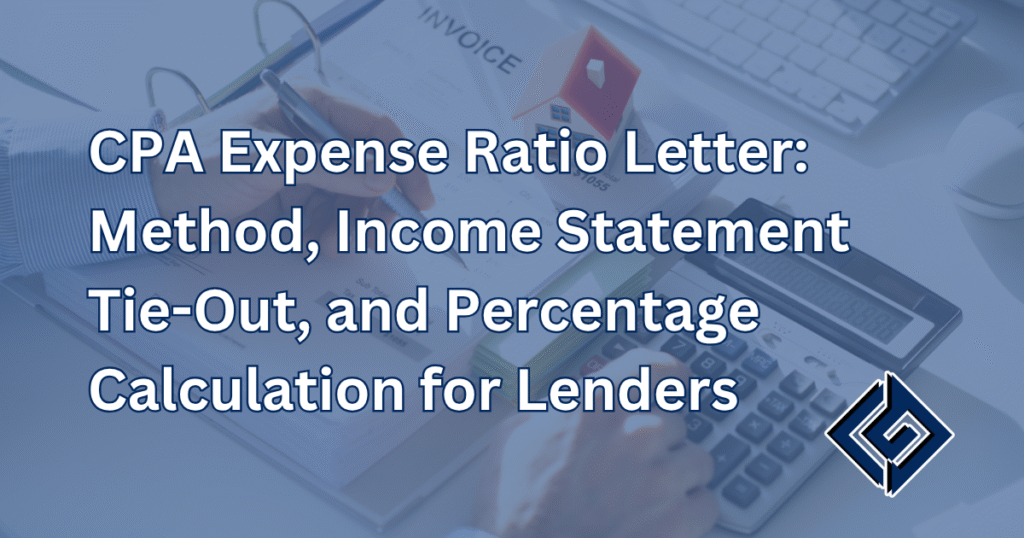A cpa expense ratio letter gives a lender a clear percentage based on real records.
It shows how expenses map to income.
It ties the math to the income statement and other financial statements.
It states scope and limits in writing.
What the Letter Is—and Why Lenders Ask
A Certified Public Accountant issues a short letter on firm letterhead.
It presents an expense ratio as a number or range.
It cites the period and the records used.
It helps mortgage lenders assess creditworthiness for home loans and mortgages.
Why it helps underwriting
- Documents the ratio used in the mortgage worksheet.
- Improves accuracy and credibility for investors and credit teams.
- Reduces back-and-forth on business expense assumptions.
Where it is used
- Self-employed borrowers.
- Small businesses with variable margins.
- Rental or landlords files that request a formal verification.
Scope, Standards, and Limits
The letter is accounting work.
It is not an audit or audit report.
Standards we follow
- AICPA(American Institute of Certified Public Accountants) ethics and third-party letter boundaries.
- GAAP(Generally Accepted Accounting Principles) references when needed for financial reporting terms.
- Alignment with tax law captions when the lender wants tax-to-books bridges.
Limits that protect everyone
- No forward-looking opinion on cash flows, appraisals, or future profits.
- No assurance on internal controls unless separately engaged.
- A clear disclaimer that this is not auditing under assurance standards.
Method: How the Expense Ratio Is Calculated
The ratio should be simple and reproducible.
Lenders prefer a one-line formula and a short narrative.
Basic formula (illustrative)
- Expense Ratio = Total Operating Expenses ÷ Gross Income for the stated period.
- Periods: YTD, trailing twelve months, or a lender-specified window.
What counts as “expenses”
- Operating categories from the income statement.
- Exclude owner draws and non-operating items unless requested.
- Note any reclassifications for clarity.
Tie-out steps
- Agree totals to management financial statements.
- Reconcile revenue to deposits when requested.
- Cross-reference to filed tax schedules if the lender needs that link.
Income Statement Tie-Out: Keeping It Verifiable
Tie-out is the heart of the letter.
Underwriters need a trail they can trace in minutes.
Records we use
- YTD P&L and prior-year comparative.
- Balance sheet to confirm obvious misclassifications.
- Bank activity for spot checks of revenue or major expenses.
Common adjustments
- Remove one-time items when the lender asks for “normalized” results
- Flag owner benefits that distort operating margin.
- Disclose methods in one short paragraph.
Notes on financial statements vs tax returns
- If the letter bridges books to IRS filings, identify the caption mapping.
- Keep the bridge high level.
- Avoid assurance language.
When to Add a CPA Letter of Explanation
Sometimes a ratio needs context.
Add a companion cpa letter of explanation when a single percentage does not tell the whole story.
Good candidates for an explanation letter
- Large shifts after a vendor change or a pricing reset.
- Short-term projects with unusual costs.
- One-time compliance or remediation expenses.
What the explanation adds
- One paragraph of explanation in plain language.
- Page references to the financial statements already in the file.
- The same scope and limits as the expense-ratio letter.
Documentation Checklist for Faster Turnaround
Short list. Clean copies help the decision.
Borrower provides
- YTD income statement and balance sheet (PDF).
- Prior-year P&L for comparison.
- Recent bank activity if deposit checks are requested.
- If used for refinance, include the lender’s worksheet or requested ratio definition.
CPA delivers
- Letter on firm letterhead with the ratio, method, and period.
- CPA credentials and license jurisdiction.
- Signature and date.
- Optional “books-to-tax” bridge if the lender requires it.
Expense Ratio Letter Sample
Subject: CPA Expense Ratio Letter — [Borrower / Loan #]
I am a CPA for [Client]. For the period [dates], I reviewed management financial statements (P&L and balance sheet) and performed limited tie-outs.
Method: Expense Ratio = Total Operating Expenses ÷ Gross Income.
Result: [XX.X%] for [period].
Procedures were limited to comparisons and recomputations. This is not an audit, review, or assurance engagement. No opinion is expressed on future results, debt service, appraisals, or internal controls.
[Name], CPA — [Firm], License [State]
Risk, Compliance, & Trust
Credit teams care about controls and acceptance.
Your package should show professionalism and restraint.
For lenders and investors
- Defined scope and tie-out steps.
- Clear math and source references.
- A neutral tone that enhances credibility.
Trust Factor
- Expertise: licensed CPA, relevant accounting and tax planning experience.
- Experience: years in practice, borrower’s industry familiarity.
- Authoritativeness: alignment to AICPA and lender guidance.
- Trust: no overreach, consistent terminology, secure delivery.
Professional liability notes
- CPAs avoid sweeping conclusions to manage professional liability.
- Underwriters keep the letter with the worksheet for audit trails.
